The senior english major students’ perception of cohesion in academic Ielts writing task 2
Abstract: Among the four language skills of English assessed by IELTS, academic
writing poses difficulties for candidates, and it is not an exception for Vietnamese testtakers. It is essential that the candidates should be aware of its evaluation in order to
achieve a high score in writing module. One criterion used to assess IELTS writing task
2 is ‘cohesion and coherence’. Cohesion refers to the use of linguistic devices to make
ideas in the text cohere, which, in turn, contributes to the coherence of the text as a
whole. This paper presents a study on Quang Nam University English major students’
perception of academic IELTS writing task 2, particularly its cohesion criterion. The
research suggests practical implications for teaching English major students academic
IELTS writing task 2 to effectively compose their piece of writing.
Key words: IELTS academic writing, cohesion, perception, criteria
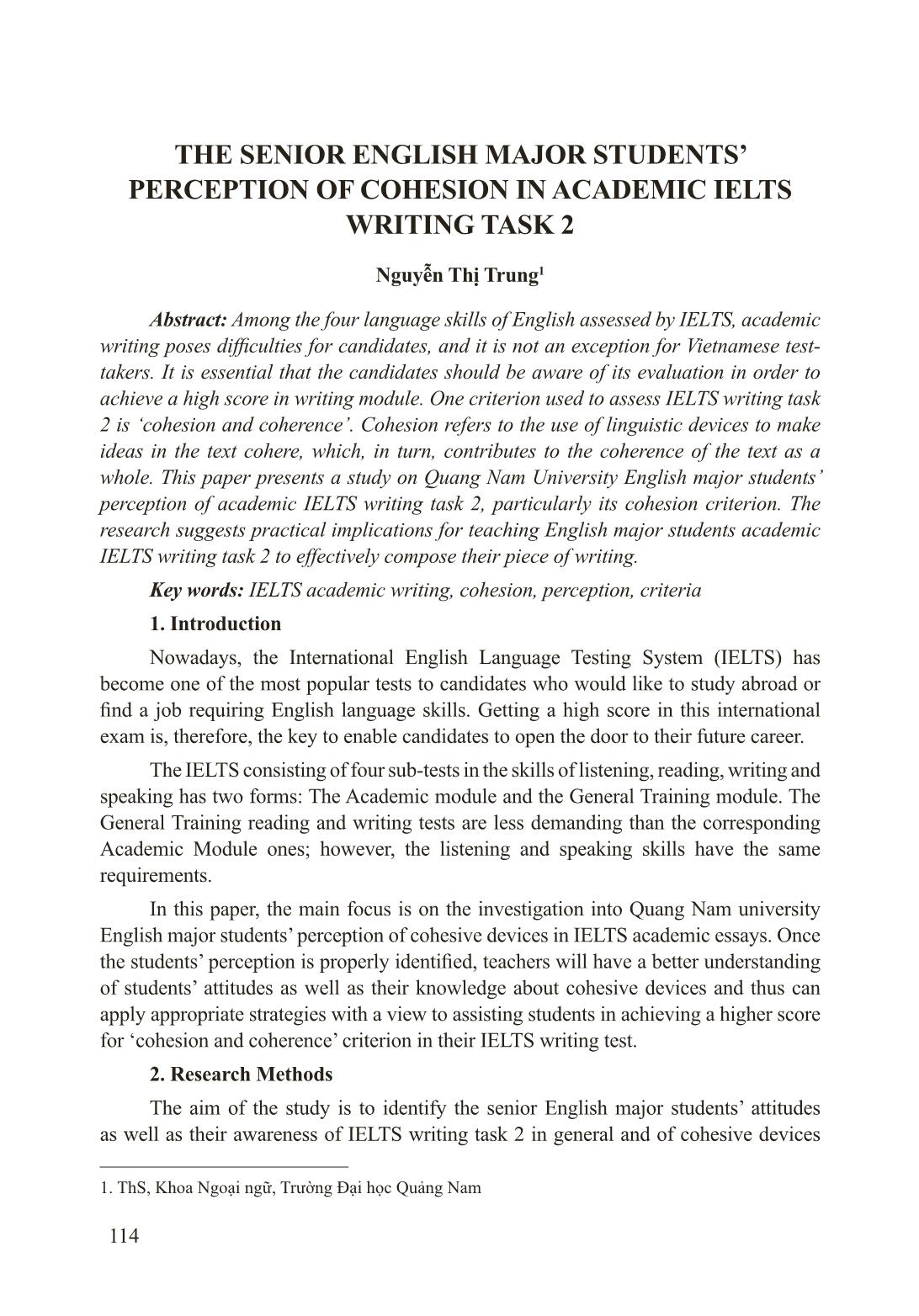
Trang 1
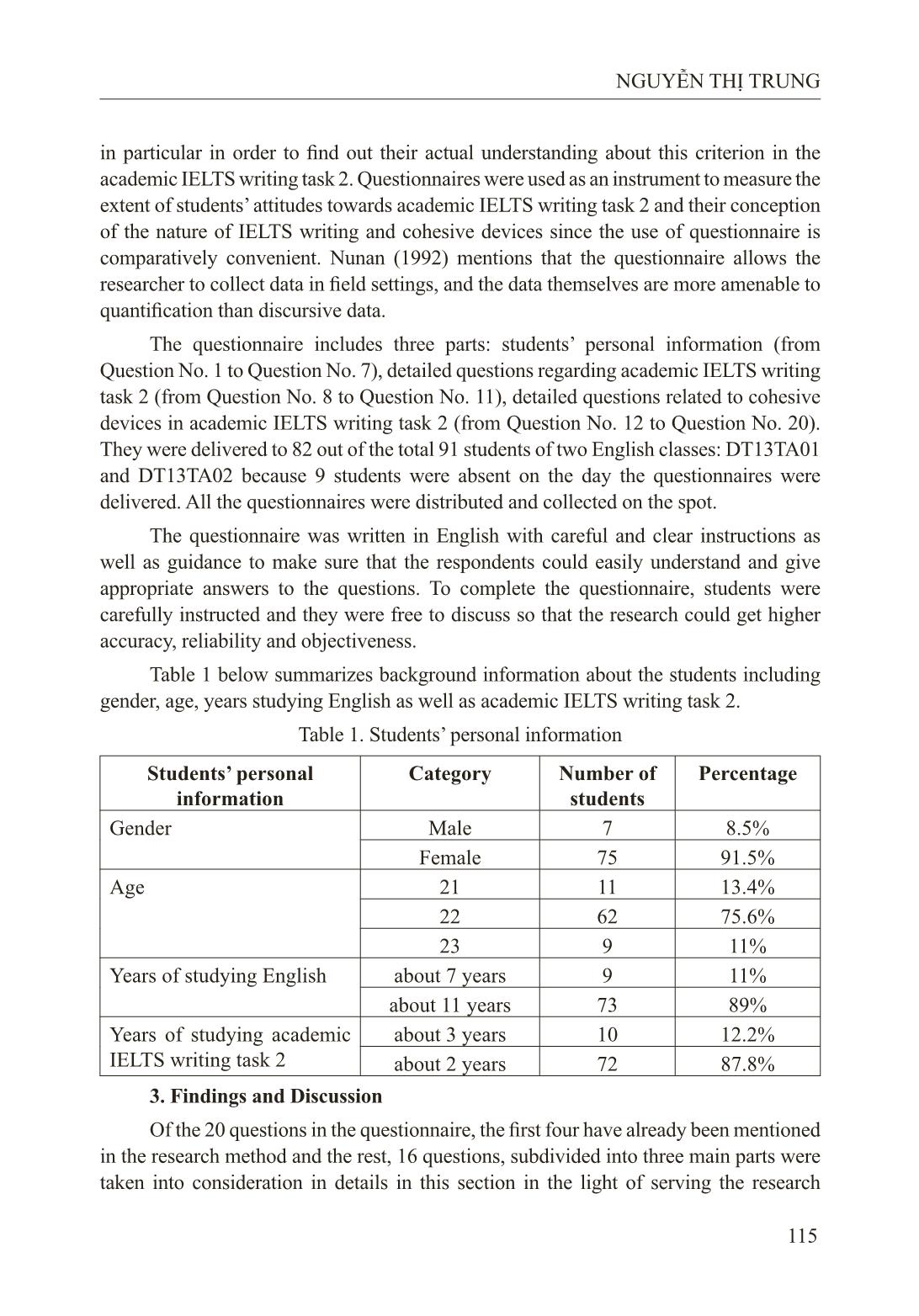
Trang 2
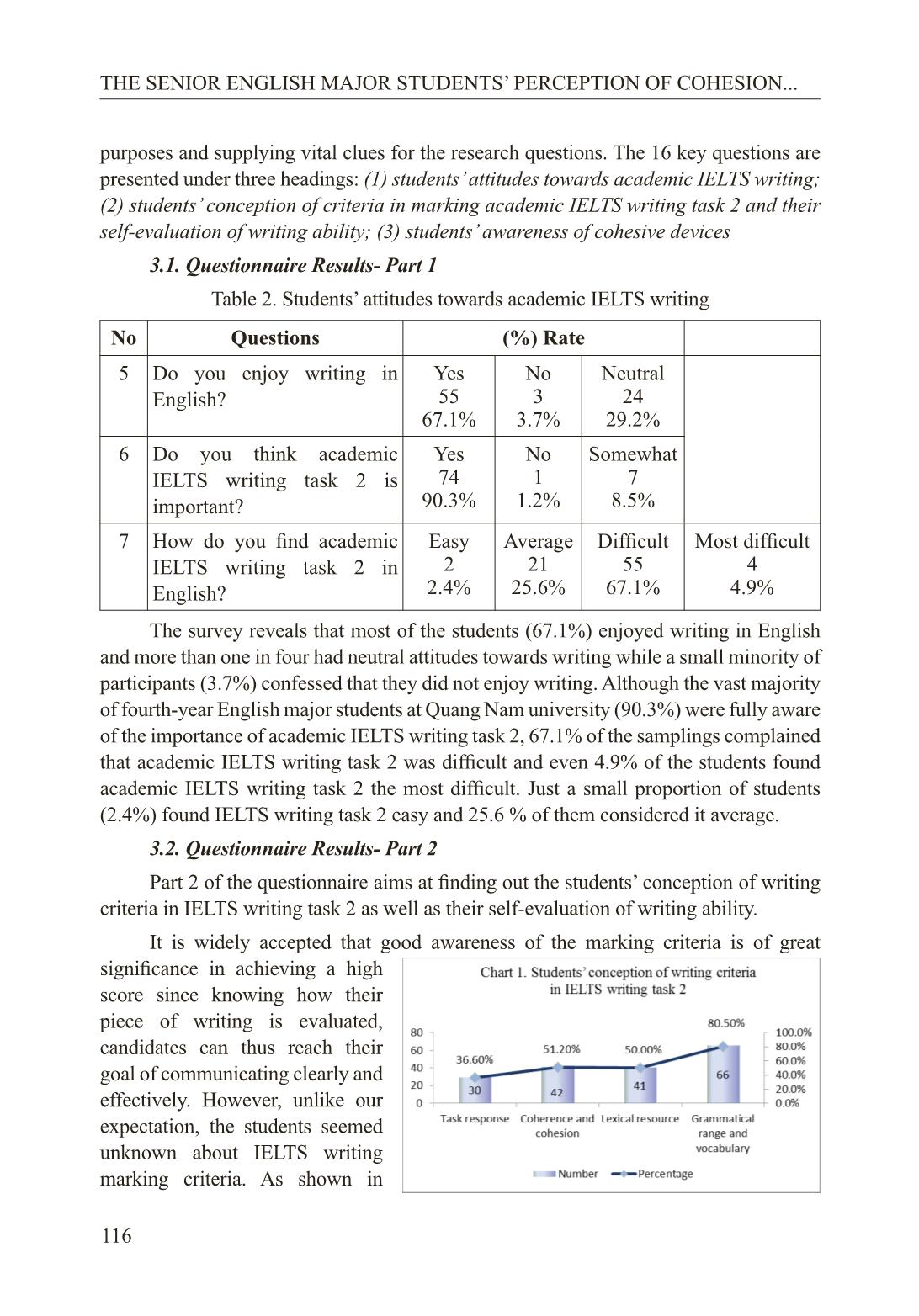
Trang 3

Trang 4
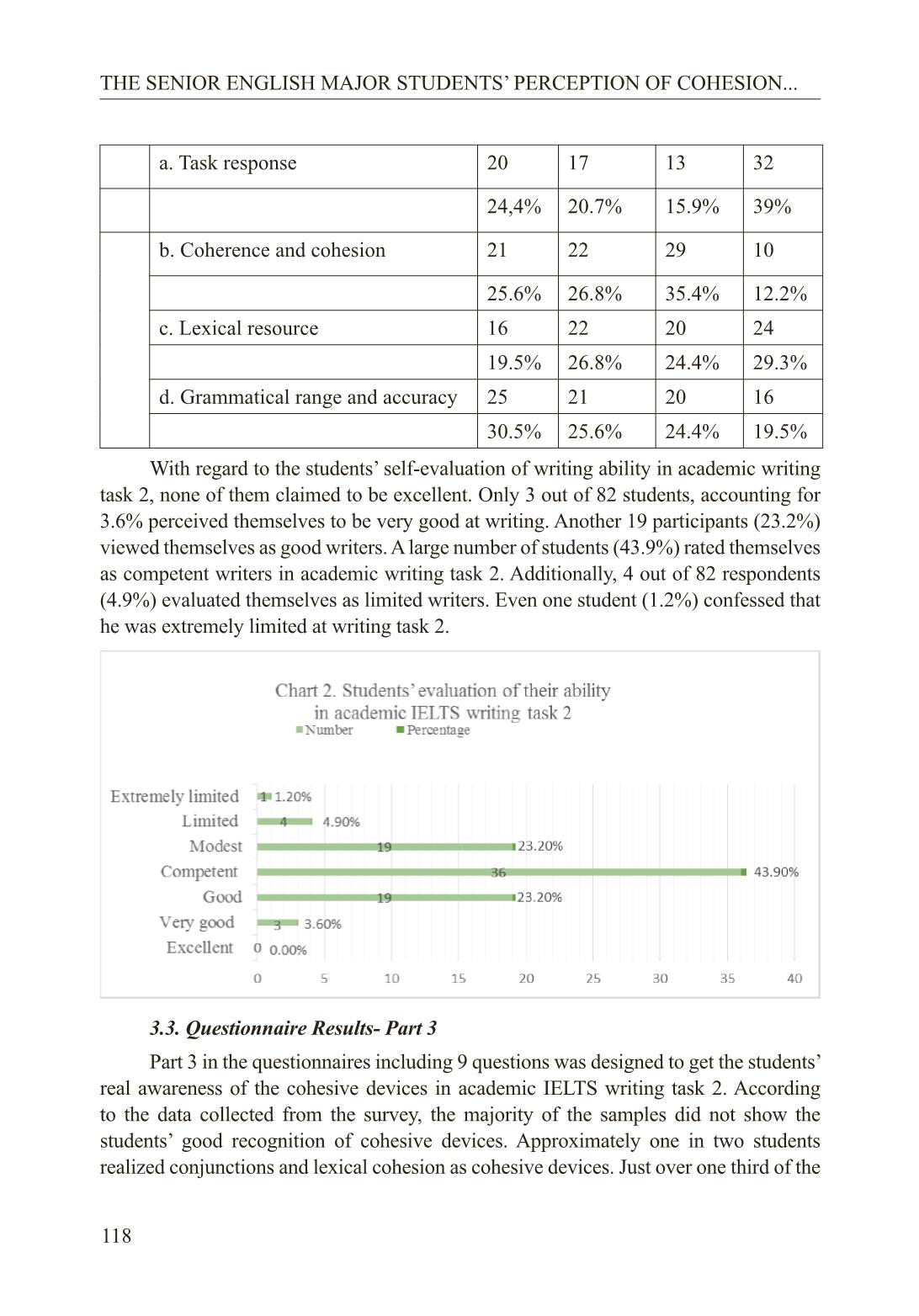
Trang 5
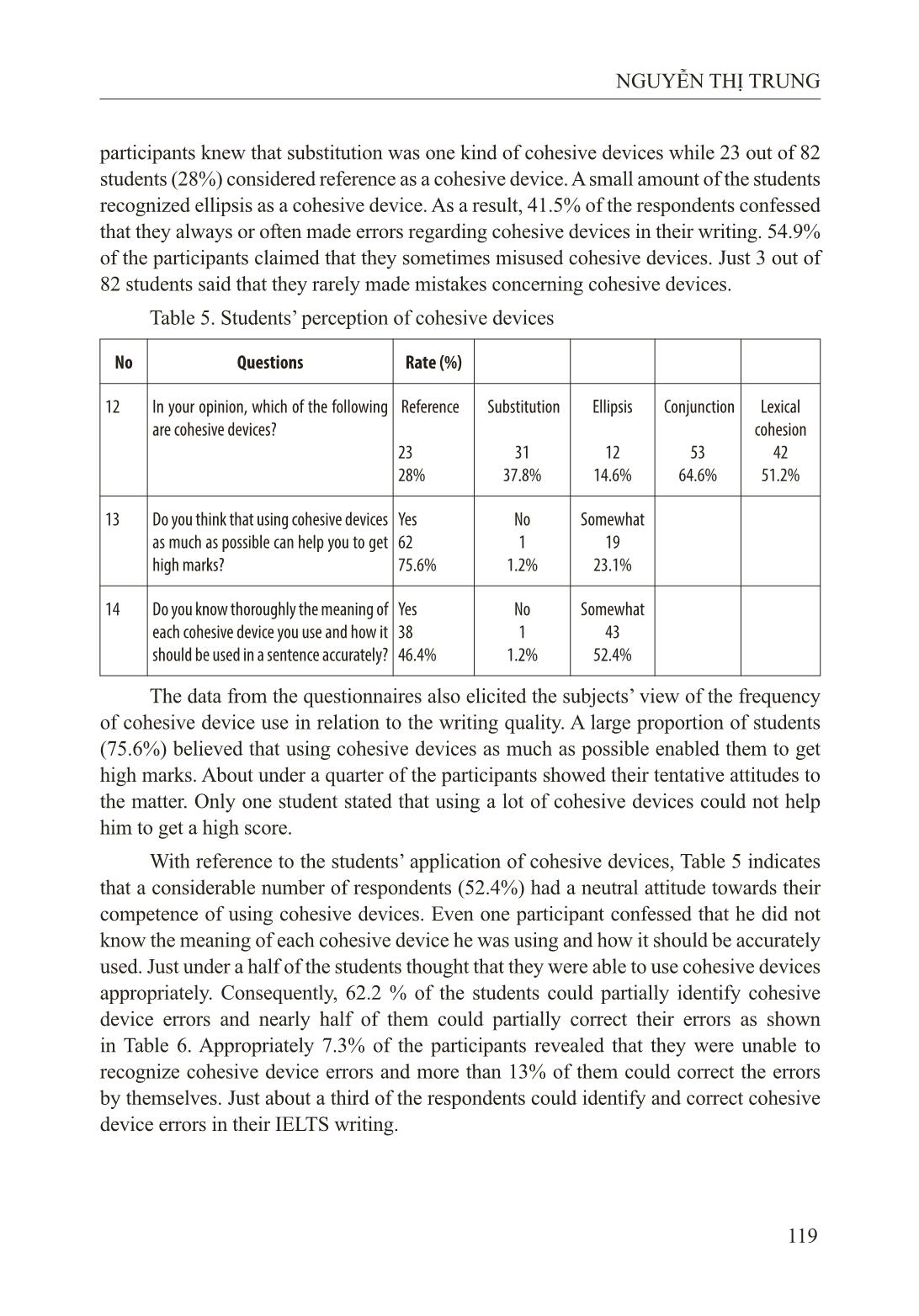
Trang 6

Trang 7
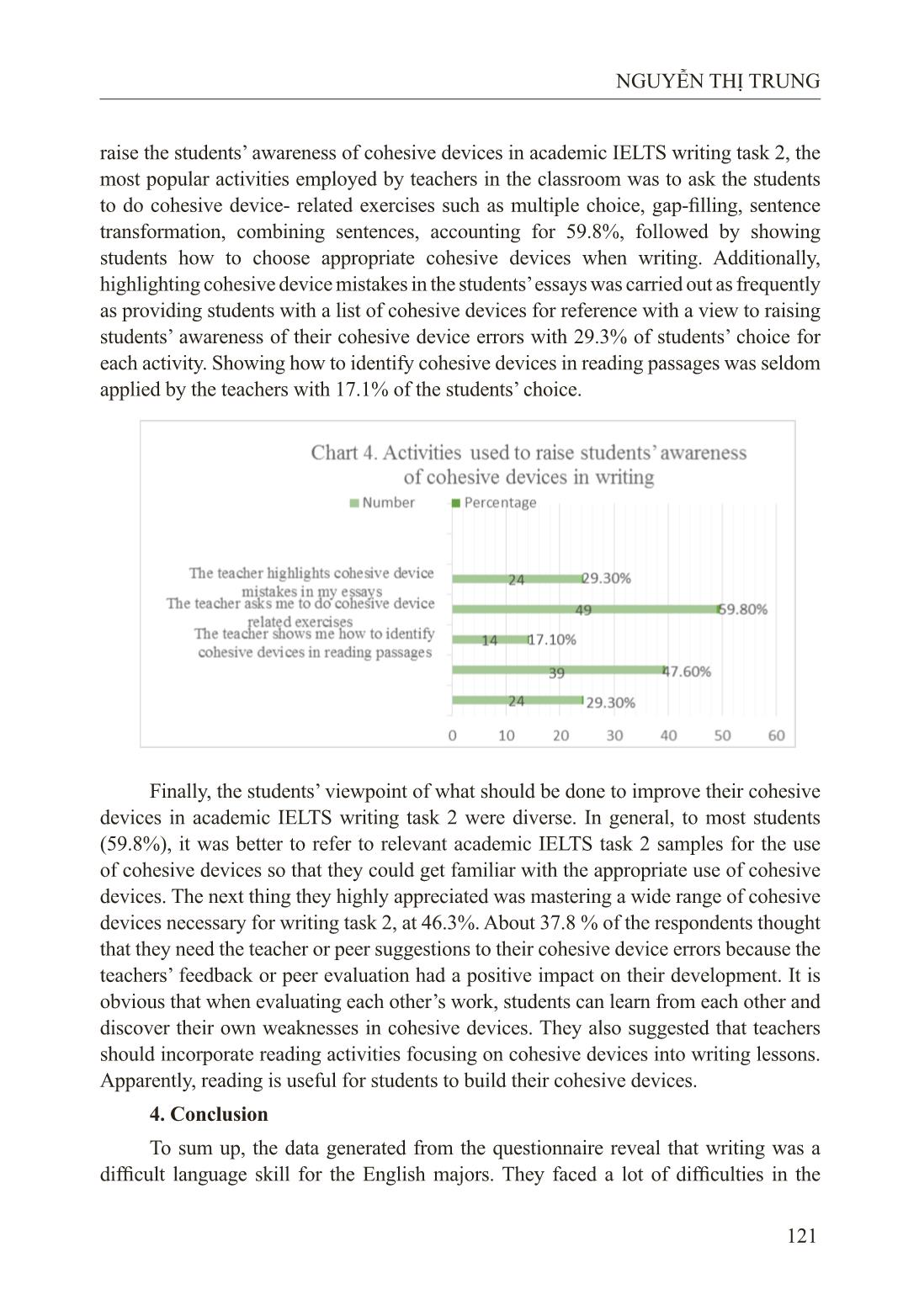
Trang 8
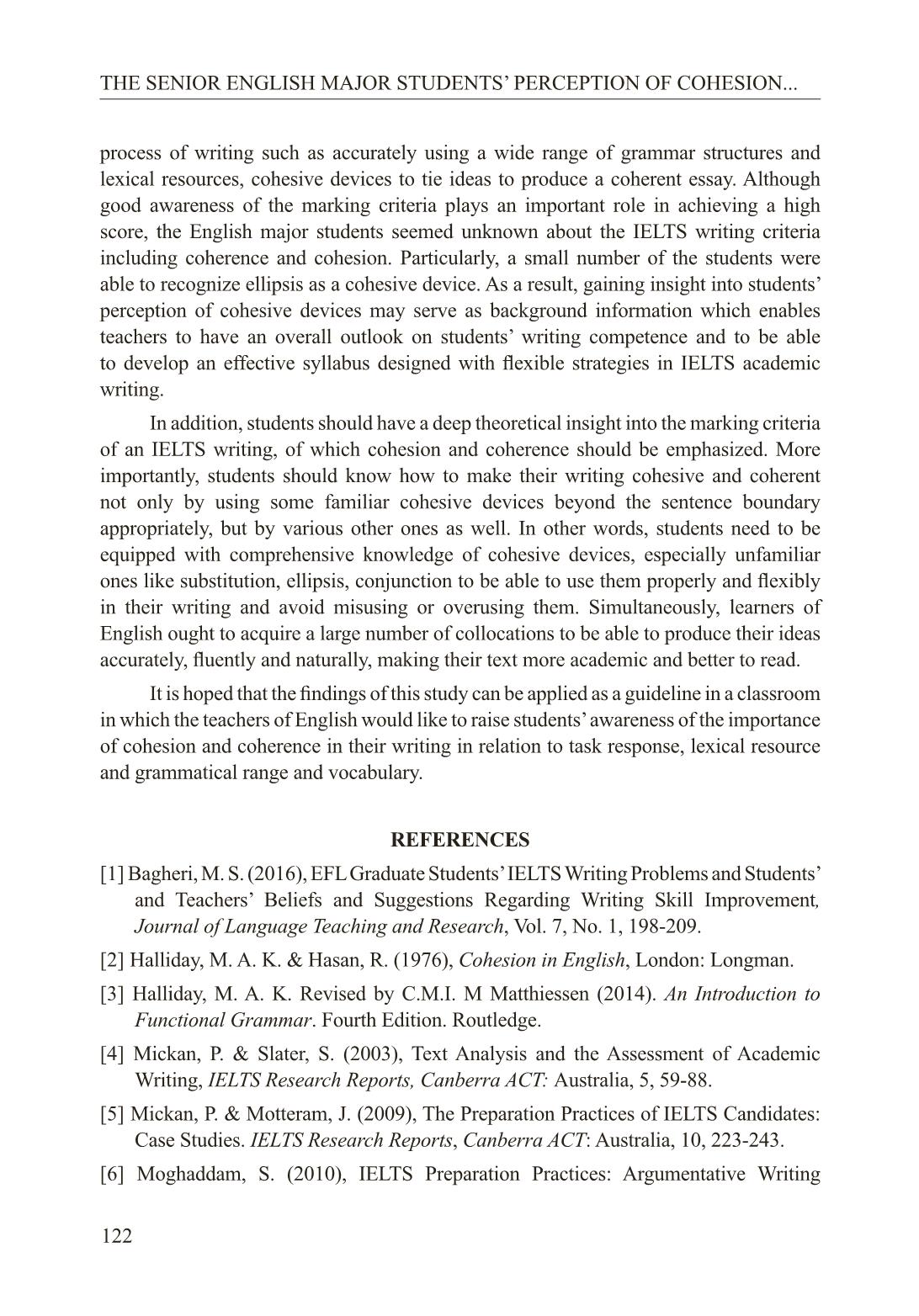
Trang 9
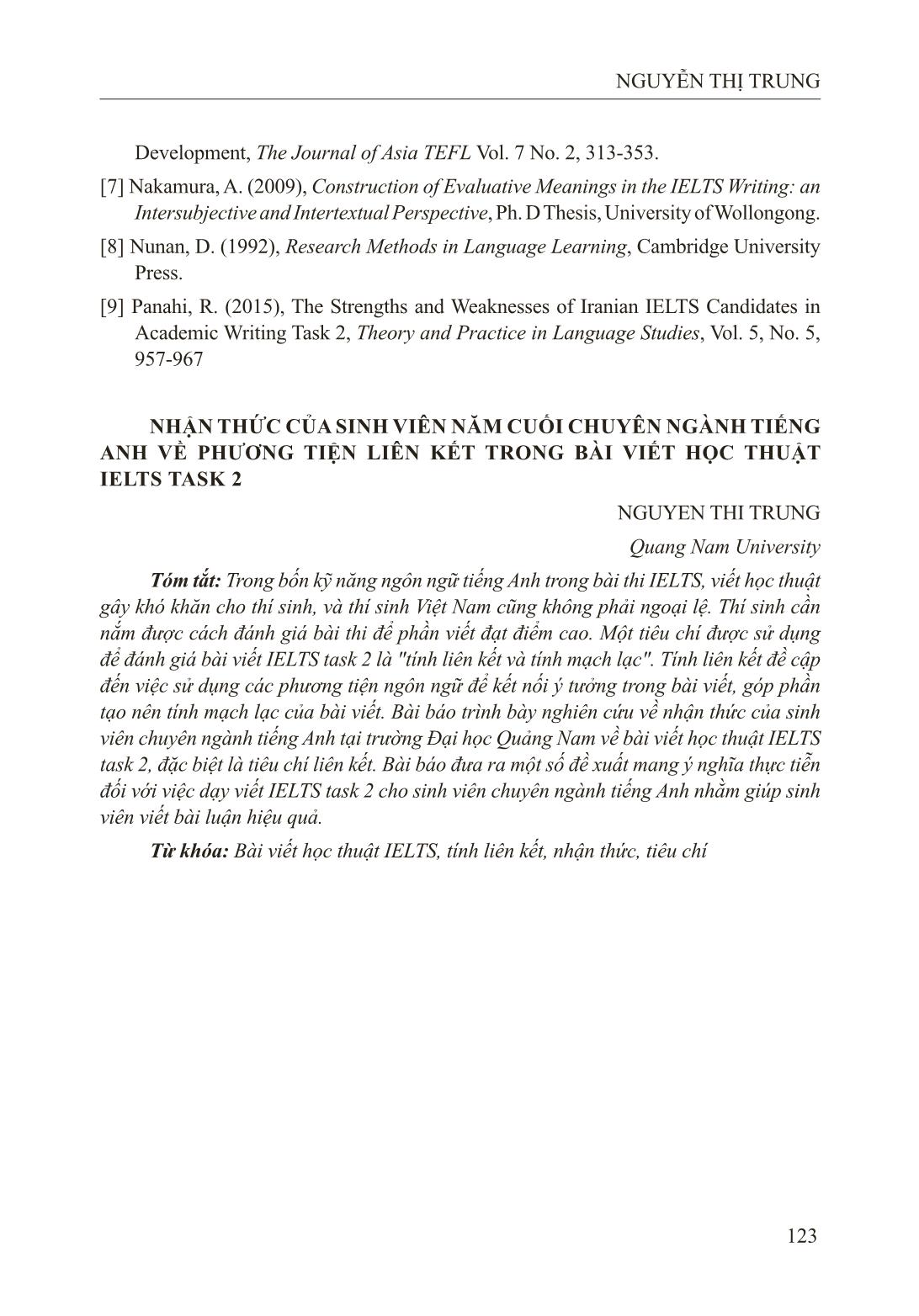
Trang 10
Tóm tắt nội dung tài liệu: The senior english major students’ perception of cohesion in academic Ielts writing task 2
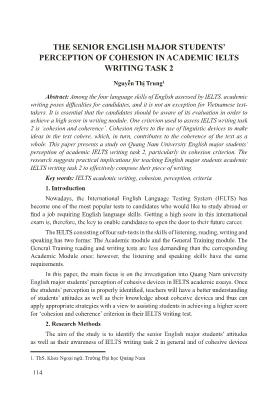
114 THE SENIOR ENGLISH MAJOR STUDENTS’ PERCEPTION OF COHESION IN ACADEMIC IELTS WRITING TASK 2 Nguyễn Thị Trung1 Abstract: Among the four language skills of English assessed by IELTS, academic writing poses difficulties for candidates, and it is not an exception for Vietnamese test- takers. It is essential that the candidates should be aware of its evaluation in order to achieve a high score in writing module. One criterion used to assess IELTS writing task 2 is ‘cohesion and coherence’. Cohesion refers to the use of linguistic devices to make ideas in the text cohere, which, in turn, contributes to the coherence of the text as a whole. This paper presents a study on Quang Nam University English major students’ perception of academic IELTS writing task 2, particularly its cohesion criterion. The research suggests practical implications for teaching English major students academic IELTS writing task 2 to effectively compose their piece of writing. Key words: IELTS academic writing, cohesion, perception, criteria 1. Introduction Nowadays, the International English Language Testing System (IELTS) has become one of the most popular tests to candidates who would like to study abroad or find a job requiring English language skills. Getting a high score in this international exam is, therefore, the key to enable candidates to open the door to their future career. The IELTS consisting of four sub-tests in the skills of listening, reading, writing and speaking has two forms: The Academic module and the General Training module. The General Training reading and writing tests are less demanding than the corresponding Academic Module ones; however, the listening and speaking skills have the same requirements. In this paper, the main focus is on the investigation into Quang Nam university English major students’ perception of cohesive devices in IELTS academic essays. Once the students’ perception is properly identified, teachers will have a better understanding of students’ attitudes as well as their knowledge about cohesive devices and thus can apply appropriate strategies with a view to assisting students in achieving a higher score for ‘cohesion and coherence’ criterion in their IELTS writing test. 2. Research Methods The aim of the study is to identify the senior English major students’ attitudes as well as their awareness of IELTS writing task 2 in general and of cohesive devices 1. ThS, Khoa Ngoại ngữ, Trường Đại học Quảng Nam 115 NGUYỄN THỊ TRUNG in particular in order to find out their actual understanding about this criterion in the academic IELTS writing task 2. Questionnaires were used as an instrument to measure the extent of students’ attitudes towards academic IELTS writing task 2 and their conception of the nature of IELTS writing and cohesive devices since the use of questionnaire is comparatively convenient. Nunan (1992) mentions that the questionnaire allows the researcher to collect data in field settings, and the data themselves are more amenable to quantification than discursive data. The questionnaire includes three parts: students’ personal information (from Question No. 1 to Question No. 7), detailed questions regarding academic IELTS writing task 2 (from Question No. 8 to Question No. 11), detailed questions related to cohesive devices in academic IELTS writing task 2 (from Question No. 12 to Question No. 20). They were delivered to 82 out of the total 91 students of two English classes: DT13TA01 and DT13TA02 because 9 students were absent on the day the questionnaires were delivered. All the questionnaires were distributed and collected on the spot. The questionnaire was written in English with careful and clear instructions as well as guidance to make sure that the respondents could easily understand and give appropriate answers to the questions. To complete the questionnaire, students were carefully instructed and they were free to discuss so that the research could get higher accuracy, reliability and objectiveness. Table 1 below summarizes background information about the students including gender, age, years studying English as well as academic IELTS writing task 2. Table 1. Students’ personal information Students’ personal information Category Number of students Percentage Gender Male 7 8.5% Female 75 91.5% Age 21 11 13.4% 22 62 75.6% 23 9 11% Years of studying English about 7 years 9 11% about 11 years 73 89% Years of studying academic IELTS writing task 2 about 3 years 10 12.2% about 2 years 72 87.8% 3. Findings and Discussion Of the 20 questions in the questionnaire, the first four have already been mentioned in the research method and the rest, 16 questions, subdivided into three main parts were taken into consideration in details in this section in the light of serving the research 117 NGUYỄN THỊ TRUNG Chart 1, 80.5% of the students realized grammatical range and vocabulary as one of the criteria while 51.2% of the participants viewed coherence and cohesion as one criterion. Moreover, only half of the students recognized lexical resource as one of the marking criteria and quite a small number of samples showed the students’ awareness of the fact that task response was one criterion. The data from the questionnaire revealed that students did not know much how their essays were marked. These figures were in accordance with the results obtained from the question No. 9 in which 21 out of 82 students confessed that they sometimes paid attention to these criteria in academic IELTS writing task 2. Table 3. Students’ attention towards academic IELTS writing criteria No Questions (%) Rate 9 Do you pay attention to these criteria (task achievement, coherence and cohesion, lexical resource, grammatical range and accuracy) while you practice academic IELTS ?writing task 2 Yes 61 74.4% No 0 0% Sometimes 21 23.1% In terms of the students’ own perception of the level of difficulty related to marking criteria they faced when producing academic IELTS writing task 2, over half of the students (30.5% for grade 1 and 25.6% for grade 2) argued that grammatical range and accuracy were the most challenging in their writing. Failing to use cohesive devices to connect and arrange ideas in English logically in order to produce a coherent text occupied the second position, with 25.6% for grade 1 and 26.8% for grade 2, making up 52.4% of the participants’ choices. Around 46.3% of the students (19.5% for grade 1 and 26.8% for grade 2) stated that they struggled with lexical resource. Additionally, just under half of the participants came up with obstacles in task response. Due to time constraint, some students could not present their arguments in 250 words and more. It goes without saying that competent writers must also be good time managers. If they know how to allocate their writing time suitably, they can finish the IELTS writing task successfully. Table 4. Students’ perception of academic IELTS writing criteria No Questions Rate: 1= the most difficult the least difficult = 4 1 2 3 4 10 What criterion do you think is the most difficult to achieve? 119 NGUYỄN THỊ TRUNG participants knew that substitution was one kind of cohesive devices while 23 out of 82 students (28%) considered reference as a cohesive device. A small amount of the students recognized ellipsis as a cohesive device. As a result, 41.5% of the respondents confessed that they always or often made errors regarding cohesive devices in their writing. 54.9% of the participants claimed that they sometimes misused cohesive devices. Just 3 out of 82 students said that they rarely made mistakes concerning cohesive devices. Table 5. Students’ perception of cohesive devices No Questions Rate (%) 12 In your opinion, which of the following are cohesive devices? Reference 23 28% Substitution 31 37.8% Ellipsis 12 14.6% Conjunction 53 64.6% Lexical cohesion 42 51.2% 13 Do you think that using cohesive devices as much as possible can help you to get high marks? Yes 62 75.6% No 1 1.2% Somewhat 19 23.1% 14 Do you know thoroughly the meaning of each cohesive device you use and how it should be used in a sentence accurately? Yes 38 46.4% No 1 1.2% Somewhat 43 52.4% The data from the questionnaires also elicited the subjects’ view of the frequency of cohesive device use in relation to the writing quality. A large proportion of students (75.6%) believed that using cohesive devices as much as possible enabled them to get high marks. About under a quarter of the participants showed their tentative attitudes to the matter. Only one student stated that using a lot of cohesive devices could not help him to get a high score. With reference to the students’ application of cohesive devices, Table 5 indicates that a considerable number of respondents (52.4%) had a neutral attitude towards their competence of using cohesive devices. Even one participant confessed that he did not know the meaning of each cohesive device he was using and how it should be accurately used. Just under a half of the students thought that they were able to use cohesive devices appropriately. Consequently, 62.2 % of the students could partially identify cohesive device errors and nearly half of them could partially correct their errors as shown in Table 6. Appropriately 7.3% of the participants revealed that they were unable to recognize cohesive device errors and more than 13% of them could correct the errors by themselves. Just about a third of the respondents could identify and correct cohesive device errors in their IELTS writing. 122 THE SENIOR ENGLISH MAJOR STUDENTS’ PERCEPTION OF COHESION... process of writing such as accurately using a wide range of grammar structures and lexical resources, cohesive devices to tie ideas to produce a coherent essay. Although good awareness of the marking criteria plays an important role in achieving a high score, the English major students seemed unknown about the IELTS writing criteria including coherence and cohesion. Particularly, a small number of the students were able to recognize ellipsis as a cohesive device. As a result, gaining insight into students’ perception of cohesive devices may serve as background information which enables teachers to have an overall outlook on students’ writing competence and to be able to develop an effective syllabus designed with flexible strategies in IELTS academic writing. In addition, students should have a deep theoretical insight into the marking criteria of an IELTS writing, of which cohesion and coherence should be emphasized. More importantly, students should know how to make their writing cohesive and coherent not only by using some familiar cohesive devices beyond the sentence boundary appropriately, but by various other ones as well. In other words, students need to be equipped with comprehensive knowledge of cohesive devices, especially unfamiliar ones like substitution, ellipsis, conjunction to be able to use them properly and flexibly in their writing and avoid misusing or overusing them. Simultaneously, learners of English ought to acquire a large number of collocations to be able to produce their ideas accurately, fluently and naturally, making their text more academic and better to read. It is hoped that the findings of this study can be applied as a guideline in a classroom in which the teachers of English would like to raise students’ awareness of the importance of cohesion and coherence in their writing in relation to task response, lexical resource and grammatical range and vocabulary. REFERENCES [1] Bagheri, M. S. (2016), EFL Graduate Students’ IELTS Writing Problems and Students’ and Teachers’ Beliefs and Suggestions Regarding Writing Skill Improvement, Journal of Language Teaching and Research, Vol. 7, No. 1, 198-209. [2] Halliday, M. A. K. & Hasan, R. (1976), Cohesion in English, London: Longman. [3] Halliday, M. A. K. Revised by C.M.I. M Matthiessen (2014). An Introduction to Functional Grammar. Fourth Edition. Routledge. [4] Mickan, P. & Slater, S. (2003), Text Analysis and the Assessment of Academic Writing, IELTS Research Reports, Canberra ACT: Australia, 5, 59-88. [5] Mickan, P. & Motteram, J. (2009), The Preparation Practices of IELTS Candidates: Case Studies. IELTS Research Reports, Canberra ACT: Australia, 10, 223-243. [6] Moghaddam, S. (2010), IELTS Preparation Practices: Argumentative Writing 123 NGUYỄN THỊ TRUNG Development, The Journal of Asia TEFL Vol. 7 No. 2, 313-353. [7] Nakamura, A. (2009), Construction of Evaluative Meanings in the IELTS Writing: an Intersubjective and Intertextual Perspective, Ph. D Thesis, University of Wollongong. [8] Nunan, D. (1992), Research Methods in Language Learning, Cambridge University Press. [9] Panahi, R. (2015), The Strengths and Weaknesses of Iranian IELTS Candidates in Academic Writing Task 2, Theory and Practice in Language Studies, Vol. 5, No. 5, 957-967 NHẬN THỨC CỦA SINH VIÊN NĂM CUỐI CHUYÊN NGÀNH TIẾNG ANH VỀ PHƯƠNG TIỆN LIÊN KẾT TRONG BÀI VIẾT HỌC THUẬT IELTS TASK 2 NGUYEN THI TRUNG Quang Nam University Tóm tắt: Trong bốn kỹ năng ngôn ngữ tiếng Anh trong bài thi IELTS, viết học thuật gây khó khăn cho thí sinh, và thí sinh Việt Nam cũng không phải ngoại lệ. Thí sinh cần nắm được cách đánh giá bài thi để phần viết đạt điểm cao. Một tiêu chí được sử dụng để đánh giá bài viết IELTS task 2 là "tính liên kết và tính mạch lạc". Tính liên kết đề cập đến việc sử dụng các phương tiện ngôn ngữ để kết nối ý tưởng trong bài viết, góp phần tạo nên tính mạch lạc của bài viết. Bài báo trình bày nghiên cứu về nhận thức của sinh viên chuyên ngành tiếng Anh tại trường Đại học Quảng Nam về bài viết học thuật IELTS task 2, đặc biệt là tiêu chí liên kết. Bài báo đưa ra một số đề xuất mang ý nghĩa thực tiễn đối với việc dạy viết IELTS task 2 cho sinh viên chuyên ngành tiếng Anh nhằm giúp sinh viên viết bài luận hiệu quả. Từ khóa: Bài viết học thuật IELTS, tính liên kết, nhận thức, tiêu chí
File đính kèm:
 the_senior_english_major_students_perception_of_cohesion_in.pdf
the_senior_english_major_students_perception_of_cohesion_in.pdf

